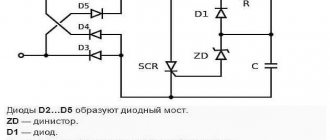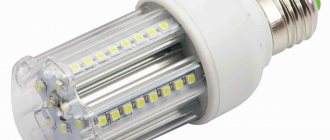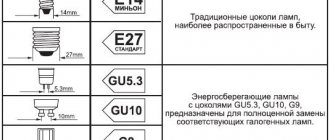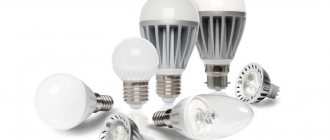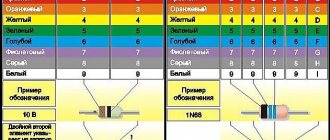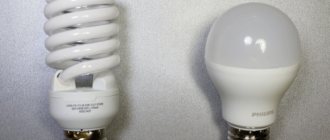What is dimming?
Any electrical appliance only works if there is some kind of load, and it can be controlled. The regulation process itself is called dimming. This can also be done with LED lamps.
This procedure is performed with a device called a “dimmer”. It is this that can provide additional energy savings.
Modern dimmers differ in performance, size, and can solve various problems of saving energy, increasing comfort in the home, and even scaring off criminals
In addition, the presented device significantly expands the functionality of LED lamps. Which is also a significant plus.
What is a dimmer
The process of controlling and regulating the load in electrical appliances is dimming. In luminaires and lamps, this process looks like adjusting the brightness of the room. And the device with which such adjustment can be made is called a dimmer. It provides both energy savings and other features of dimmable LED luminaires and lamps:
- With the help of dimming, you can regulate the saturation of lighting in a house or apartment; you can create a special atmosphere of comfort with dim light or a working atmosphere with bright lighting.
- With the help of lighting, you can zone the space not only in the house, but also in one room, and give individuality to your home.
- When leaving the house for a long time, you can scare away thieves by leaving dim light here and there, creating an atmosphere of the presence of the owners of the house.
- Modern dimmer switches have programming functions - you can set comfortable modes once for a certain time and not have to return to choosing the light brightness level every time.
- The remote control function from mobile devices allows you to control the lighting process at any time. You can also control dimmable lights using your voice, remote control, or by clapping your palms when entering the room.
An important advantage of dimmers is the ability to control one or several lighting fixtures at once. These are convenient, compact and lightweight devices that can withstand power surges, do not require special care, and are suitable for both LED lamps with standard E27, E14 sockets, as well as other lamps and electrical devices. In terms of price, regulators have a wide range, here everyone can choose the right option depending on the functions they want to get and their budget.
What advantages does the regulator provide?
As stated above, dimming primarily reduces energy consumption. This reason is already enough to connect it to LED lamps in the home and any other premises. But there is a whole list of advantages.
These include:
- The ability to change the intensity of the glow provides owners with increased living comfort and helps make any interior individual and exclusive. So, for example, a room can be divided into separate zones using lighting. It will also be possible to change the brightness depending on the time of day and needs.
- Simulating the presence of owners in the premises - this option will be indispensable during vacations or business trips, which will make it easy to mislead burglars.
- Automatic switch-off/switch-off - modern dimmers can be programmed, in addition, they can be controlled by various external devices, for example, tablets, smartphones. There are special signaling devices that send commands to power drivers.
All kinds of preset lighting and blinking modes allow you to select the best options for any time of the day once and not waste time in the future. In addition, it is not only convenient, but also allows you to save more.
The picture shows a regular sinusoid of electric current; it is in this form that it is supplied to LED lamps, but dimming in this case is impossible
Remote control is also an important advantage. With its help, a person can regulate the voltage, and, consequently, the brightness of the glow, in various ways, for example, using a remote control, radio and sound signals (claps, voice).
At the same time, modern regulators themselves are durable and unpretentious. In addition, they are convenient to use.
You also need to know that with their help you can control LED lamps with familiar standard sockets, for example, they can be the familiar E27, E14, as well as many other popular and rare ones. This greatly simplifies the creation of the system.
It is also important that dimmers are able to control the glow of one lamp, several or even a whole group. They are resistant to overloads, silent when the model is correctly selected, light in weight, and compact.
This is again a current sinusoid, but if you compare it with the previous picture, you can see that it is significantly “cut off” - that is, short pulses with long pauses are the result of dimming
The cost of such equipment varies, so the interested consumer will be able to choose the optimal solution according to his budget, which will ensure the expected result.
Advantages and disadvantages of dimmers
The advantages of various types of switches with regulators include smooth start-up of the lighting system, which can significantly increase the service life of lighting fixtures (the service life of incandescent lamps in this case increases to 40%).
Dimmers can be used not only to control light, but also to regulate the voltage of other devices (kettles, irons, heaters)
It is important to maintain a correspondence between the power of the device and the load placed on it. Such devices create endless possibilities for interior design.
With their help, it is easy to highlight a selected area and create interesting light patterns. A valuable quality of dimmers is also the ability to control light sources remotely or using sounds
Such devices create endless possibilities for interior design. With their help, it is easy to highlight a selected area and create interesting light patterns. A valuable quality of dimmers is also the ability to control light sources remotely or using sounds.
However, such devices also have their drawbacks. Dimmers can only be used to control light sources whose power corresponds to that of the device. Due to the characteristics of the output voltage, step-down transformers may not work correctly.
The devices may generate electromagnetic interference, which may interfere with the operation of radios and other devices. Certain types of lamps (especially those equipped with additional devices - electronic ballasts, drivers) in principle cannot be combined with dimmers. The efficiency of dimmers when working with incandescent lamps is quite low. Lowering the brightness of the lamps has little effect on the consumption of electricity, which turns into heat instead of light.
Types of modern dimmers
Manufacturers supply the market with a large number of different equipment that can adjust the brightness of the light. Therefore, for convenience, it is divided into types.
First of all, devices are divided according to the type of control, which is as follows:
- Mechanical , sometimes called stationary.
- Electronic - like the previous option, it is a contact type. But instead of regulators and buttons, a sensor is used. This method is modern, effective, informative and quite expensive.
- Acoustic , that is, the brightness of the glow changes as a result of some kind of sound signal that exceeds the noise level set by the user or manufacturer.
- Wireless remote control - a control panel familiar in other areas is used here, as well as smartphones and tablets. In addition, various types of signals can be used, namely infrared, radio.
With a mechanical control method, the homeowner can adjust the brightness of the glow using a push or rotary control - a regulator, buttons, keys. It transmits a signal to a controller installed in the power line.
The task of any modern dimmer is to control the supply of electric current to the power driver of an adjustable LED lamp or a group of them
That is, the procedure is similar to using a regular switch. Some regulators even have controls in the form of familiar keys. This method is effective, simple, and accessible. The only relative disadvantage is the obsolescence of this option, which results in lack of prestige.
The electronic method, apart from being informative, has no other advantages over the mechanical one. But the modern display alone, indicating the necessary information, makes this option more modern and even prestigious, which is the reason for choosing it.
The touch dimmer is the most modern, functional and practical. In addition, it is more aesthetically pleasing, but has a higher cost than a mechanical one, so the latter type is more in demand
Acoustic dimmers are also a popular control method; in addition, they are affordable and reliable. A significant drawback is the limited modes. There are only a few of them and they are pre-installed. Therefore, it is not a fact that they are ideal for the user.
In addition, there is no guarantee that this option will work correctly, since its acoustic sensor will respond to any signal of sufficient power, and this will not always give the expected result. In this case, the user will not be able to constantly monitor the situation.
A dimmer with a rotary control is structurally simple, and therefore the most accessible to a potential buyer. Plus, it's easy to operate
As mentioned above, a wireless remote method for controlling the brightness of LED lamps in a home involves the use of some kind of control panel capable of issuing the command:
- via radio channel;
- via infrared channel.
In the first case, control is possible from anywhere in the room, building, and even from outside. This option is practical and effective, but expensive, since such equipment costs a lot.
The infrared remote control also expands the user's capabilities, but requires pointing at the dimmer. Despite the relative disadvantage, this option is more popular - the equipment is more affordable.
In addition, transmission of commands using smartphones and tablets via Wi-Fi is also considered remote control. Often, such a system is also accompanied by a remote control, which increases convenience.
Today, the remote control method is the most functional, as it allows you to unleash the full potential of dimmers for LED strips, spotlights and conventional lamps. Namely, it makes it possible to use energy as economically as possible and increase comfort to the expected level.
In addition, this option allows you to automatically or smoothly turn off/on the lights, simulate the presence of owners in the rooms, and perform any other functions available to regulators.
A push-type mechanical dimmer is also one of the relatively inexpensive products. In some cases, using keys is more convenient to control, and the aesthetic properties are often higher than those of a rotary analogue
A potential buyer needs to know that today solutions are increasingly being used that can be controlled using several methods at once. This makes the procedure for adjusting the brightness of lamps more reliable and convenient. The only disadvantage of combined control systems is their considerable cost.
Additionally, all dimmers produced today can be divided according to the installation method.
Which are as follows:
- overhead - such devices are installed instead of conventional switches;
- built-in - they are mounted in a distribution box, a specially made niche;
- modular or panel - their place is on the DIN rail in the electrical panel room, but due to their functionality, performance and high cost, such residential devices are rarely used.
You should know that overhead models are the most popular due to their availability and ease of installation. Practice-tested methods for connecting dimmers are given in our recommended article.
Classification of devices
All modern light controllers are classified according to the type of housing, as well as in accordance with the control characteristics and the main specific features of the luminaires in which such a device is supposed to be mounted.
According to the method of adjustment
Depending on the control method, light controllers differ: mechanical and electronic, contact and non-contact, as well as remote and acoustic types.
Mechanical
Reducing the power of an electrical appliance is achieved by trimming the current sinusoid
Mechanical devices are based on potentiometers, which are not connected directly to the load level, but transmit a signal through a control circuit to any type of power element, represented by a rheostat, inductor or thyristor. The advantage is simplicity and affordable cost.
Sensory
Older incandescent lamps use a voltage variation method to control brightness
Touch models are represented by rotary and push keys, and some types are characterized by the presence of a control function for several lighting fixtures at once with a simple color change. The advantages are associated with the lack of tendency of the device to wear out or jam.
Acoustic
Modern devices regulate brightness using pulse width modulation
The acoustic device is triggered by influencing the sensor with commands or noise, under conditions of giving a so-called voice command. Such models of modern dimmer have a slight drawback, which involves a change in the brightness of the light when animals move involuntarily or household objects fall.
Remote
Rheostats of older models do not save electricity, but dissipate it in the form of heat
Remote models operate via a remote control, which allows you to adjust the lighting level without the need to use a traditional switch. The operation is based on the radiation of infrared (IR) or standard radio waves (RF), but the control panel requires timely replacement of batteries.
By type of execution
Modern light controllers also differ in type of design and can be designed for several types of use.
Modular
When the regulator operates correctly, the sine wave alternates short pulses with long pauses
The modular option regulates the level of illumination in public places, represented by staircases, corridors and entrances. This type of regulator is mounted inside the distribution panel. Direct control of lighting devices in this case is carried out by a push-button or single-key switch.
Monoblock
Increasing the duration of pauses between pulses reduces the intensity of the device's glow
The monoblock version is standardly mounted in the phase break section of the electrical circuit going to the load part of the lighting fixtures and is used as a traditional switch.
Blocky
Dimmable lamps can operate between 10% and 100% of their output.
Block models involve fixing the light controller directly with the switch in the form of a standard “socket-switch” block.
By control method
In domestic conditions, the most widely used are classic and affordable monoblock luminous flux controllers, which traditionally differ in the way they are controlled.
Turning
Correct selection and installation of the regulator will significantly increase its service life
The rotary version has a rotating knob, which, when installed in the extreme left position, turns off the lighting. Gradually turning the knob to the right increases the brightness of the lamp.
Key
The main components of the variator: triac, pulse formation unit, diac (dinistor)
The key version is very similar in appearance to conventional two-key switches. Using the keys, you can turn the lighting device on and off, and also adjust the lighting power.
Turn-push
Additional parts of the variator: resistors and capacitors
The rotary-push version has a principle of operation similar to a rotary device, but to turn on the lighting system you need to “retract” the handle a little.
By type of adjustable lamps
Light controllers should also be selected depending on what type of lighting fixtures are intended to be used in the lighting system.
For incandescent lamps
The triac plays the role of a transmission mechanism for electricity
For incandescent lamps and high-voltage halogen light sources, the simplest devices are used that change the voltage and regulate the glow power of the filament.
Electronic for LED lamps
The direction of current movement is determined by the cathode and anode, changing places
For LED lamps, it is necessary to install regulators that have pulse modulation of the current frequency.
For halogen lamps
For low voltage halogen lamps, the variator must have a step-down transformer, or a device is selected in accordance with the type of existing transformer marked C or RL.
How does regulation happen?
Any dimmer is a device that is built in according to the principle of a traditional switch, familiar to all users, or instead of it.
The main condition is that it should be located before the LED lamp power driver, although in some cases this is no longer a mandatory parameter, but such a pleasure is expensive.
To a person unfamiliar with a dimmer, it may seem that it simply changes the voltage, as conventional regulators do, but this is not the case. The design of dimmable LED lamps is complex; the principle of their operation is somewhat different from the usual devices that illuminated the room with incandescent lamps.
Regardless of design and size, all mechanical regulators perform only the simplest functions, such as turning on/off, changing brightness
Since all LEDs operate in a narrow voltage range, even a slight decrease in voltage will cause the lighting fixtures to flicker, go out, or not turn on at all.
To avoid this, dimmers make adjustments based not on the traditional principle of reducing the load supplied to the lamp, but on the use of pole-width modulation. With the help of which electric current is supplied in short pulses with relatively long pauses between them.
The described procedure is performed up to hundreds of times every second. Thus, any LED lamp can be made to stably illuminate the room at 10-100% of its capabilities.
Exploitation
Dimmers are used to regulate special LED lamps - dimmable ones. Conventional LED lamps cannot be used in conjunction with a voltage regulator.
If a non-dimmable LED lamp is connected to a dimmer, it will only flicker, turn on and off. It is impossible to adjust its brightness; it may burn out. Dimmable lamps are easily recognized by the corresponding markings on the packaging.
There are LED lamps that have a quenching capacitor. They can be adjusted, but within a very small range, so they are also not suitable for use with a dimmer. To make sense in purchasing a regulator, use it with dimmable lamps.
Possibilities when using dimmers:
- Control from different points. There are regular and pass-through dimmers. Thanks to the latter, you can control the lamps from different rooms.
- Automatic on/off. Dimmers for chandeliers and other lamps can not only be built into a timer, but also provide programming. They are also allowed to connect to smartphones. By programming the glow modes for different times of the day, you don’t have to waste time on adjustments.
- Remote control. It allows you to adjust the brightness of the glow in various ways - by voice or remote control.
- Wi-Fi control. You can change the brightness in your home from anywhere in the world. They do this using a smartphone, tablet, etc.
- Adjusting color temperature. When the brightness changes, the color of the radiation also changes. When dimming, the light from the lamps becomes different. Color temperature varies from 2,700 K to 1,500 K - this is an approximate range.
What lamps can be used?
Every potential owner of a dimmer should remember that only special LED lamps that can be dimmed can be used with it.
They can be easily identified by the inscription “Dimmable” or the corresponding sign on the packaging. This condition is mandatory, since the use of conventional LED lamps will only lead to their frequent flickering, and a smooth glow cannot be achieved; if the voltage does not correspond to the specified voltage, then they simply do not turn on.
Dimmers with combined control are more functional, since in addition to switching on/off and regulation, they can be programmed. They are also more convenient to use
In addition, this kind of experiment will lead to rapid wear of the LED lamp or the dimmer itself and further failure.
Dimmer incompatibility
It often happens that the selected type of lamp is not compatible with the dimmer. In most cases, this is caused by a difference in the principles of regulation at the trailing or leading edge. Some lamps are not designed to be connected to a dimmer.
In addition, often the incompatibility of the dimmer with the lamp can be manifested by the lack of ignition of the lamp when the regulator lever is moved to the minimum value. Only when the lever is turned to a certain level does the lamp light up. Some lamps begin to crackle when you try to adjust their brightness with a dimmer. This also indicates that the dimmer and lamp are incompatible.
Compatibility is always an issue
A consumer interested in using brightness control equipment should know that he will not only have to buy the necessary system components, but also match them together. Often there is a problem of inconsistency between the dimmer and the purchased LED lamp.
This happens due to the fact that there are a large number of electronic circuits for power drivers for lighting devices and control devices on the market.
Products of any domestic, European or Chinese manufacturer have the right to have a voltage threshold unique to them for inclusion. Also, incompatibility can lead to the fact that the range of adjustments is narrowed, and significantly.
For example, there are LED lighting devices that can turn on and operate even at 5% of the rated power. An incorrectly selected dimmer will only be able to control them within 40-100%. This will significantly reduce the functionality of the process.
The dimmer control panel can provide a radio or infrared signal. The first option is more functional, the second is cheaper, which is why it is the most popular
This feature will lead to the fact that the consumer will not save enough energy or will not be able to provide himself with the expected level of comfort. This is also a significant drawback. Other signs of malfunction may also appear.
The most common are the following:
- The power driver of the existing LED lamp makes loud noises that are unpleasant to the user during operation or cannot start the lighting device.
- The maximum voltage at the output of the dimmer does not reach the required 220 Volts, which makes it impossible to use the light bulb at full power.
- Short-term bright flashes when the lighting device is turned on, the duration of which usually does not exceed 1 second.
- Various interruptions in the functioning of the regulator itself, which will not allow you to effectively control LED lamps.
All of the above points indicate that the selection of equipment should be done carefully and competently.
Application
What a dimmer is is more or less clear. Voltage is supplied to the lamp, we change its level and thus adjust the brightness of the lamp. Now a few words about when and where this device is used.
Agree, quite often situations arise when it is necessary to reduce the brightness of the light:
- often the flow of lighting needs to be reduced in the bedroom before going to bed;
- Some design rooms require changes in the light pattern;
- Sometimes indoor lighting is switched to the so-called standby mode in order to reduce energy consumption.
In industrial and domestic premises, LED lamps are configured for different consumption modes. At the same time, optimal lighting is selected and due to this, significant energy savings are achieved.
As for design ideas, it has now become fashionable in large living rooms or halls to use secondary lighting of individual areas. Secondary lighting is thought out to the smallest detail, and with the help of dimmers you can increase the lighting and focus attention on some interior details (a painting on the wall, a beautiful vase installed in a niche, etc.) Thus, with the help of lighting, the necessary thing comes out in the room first plan.
LED lamps, adjustable using dimmers, allow you to get a colorful effect during some concerts, advertising or special events.
The dimmer is very convenient for home parties. When guests are sitting at the table, bright lighting is required, but during dancing you can dim it. It is especially comfortable and beneficial to use such a device during a romantic dinner or date, when it is not necessary for the lamp to be on at full power.
And these are just some of the general examples. Surely, everyone has their own option for using dimmers. So this thing is necessary, convenient and cost-effective; you can install it at home and recommend it to your friends.
How to choose a dimmer and compatible lamps?
In order for the brightness regulator together with lighting devices to give the desired result, when choosing them, you need to take into account a number of points. Initially, a person needs to decide what he wants to get from dimming, whether it is possible to use it in the right room or building.
Next, they decide on the desired option for controlling the equipment - mechanical or remote, or perhaps it is better to use other methods. After resolving this issue, it is necessary to calculate whether the potential buyer is ready to pay the required amount of money.
Floor dimmers are low-power, but no less effective than other types of dimmers. Therefore, they are often used to control bedside lamps and other small lamps.
If all of the above steps are completed successfully, then you should proceed to the actual choice of dimmer. In this case, a person must take into account its power. Why do you need to imagine how many lamps the device will control?
You also need to know exactly the power of each of them - by adding up all the values, the user will know what performance his dimmer should have. It is impossible to do without these calculations, because insufficient power will lead to the fact that the purchased regulator will immediately fail, and in the best case, it will simply not start.
In addition, if in the future it is possible to increase the number of lamps or their power, then when purchasing a regulator you need to take this into account, or the result will again be disastrous. Even if the owner of the premises does not plan to install an additional number of LED lamps, there should still be a power reserve. And no less than 20%.
It is best to create a safety margin of 50%. For example, if the total power of all lamps used is 100 W, then the same indicator for the brightness control should be at least 120 W, and optimally 150 W.
All popular and not so popular varieties of LED lamps are dimmable, and with different bases, which always allows you to choose the right one
The power of LED computing lamps is easy to find out. All you need to do for this is look at the packaging, if the lighting fixture is new and it has been preserved. Otherwise, you need to carefully examine the LED lamps themselves, since most manufacturers indicate all the main characteristics on them.
When choosing a dimmer for more than one lighting fixture, keep in mind that their minimum power is 25-40 W. Therefore, when you plan to use several low-power LED lamps that collectively do not reach the specified values, you will have to install a suitable device for each of them separately.
When choosing a regulator, you should give preference to a product that can provide glow at a minimum level. The reason is that all LED lamps have sufficient brightness, so the dimmer will not be able to effectively reduce it, and the consumer, accordingly, will not get the maximum effect from using the device.
To make sure that the LED lamp is truly dimmable, just inspect the packaging. Manufacturers indicate all important information on it
Before purchasing, a potential buyer should first of all pay attention to products from well-known manufacturers. This will ensure stability and quality for many years, although their cost is significantly higher than that of similar devices made in the Middle Kingdom by other little-known market participants.
Often, choosing an LED lamp and dimmer can only be done experimentally. As a result, it is initially necessary to install control equipment, and only then select lighting fixtures.
Moreover, you should find out from the seller whether it is possible to return the purchased LED lamp if it turns out to be incompatible with the dimmer. Lighting devices must also be produced by popular manufacturers, among which there are quite well-known names: Siemens, Osram, Philips, Gauss, Schneider Electric, ASD, LEGRAND, Feron and others.
When purchasing LED lamps, Chinese companies should, in most cases, be ignored. Since, to reduce cost, they are equipped with low-quality crystals, the degradation of which will begin almost immediately after use.
As a result, this feature will lead to a significant dimming of the lighting and, if in a conventional lamp this is leveled out by the stability of the operating mode, then with regulation one can expect a clear deterioration in performance characteristics, which will reduce savings and comfort.
Dimmers used instead of traditional switches are structurally simple, and therefore almost every person is able to install them on their own, but you should remember safety measures
To reduce the likelihood of LED lamps being incompatible with the control device, the buyer should have some knowledge and carefully study the information provided by the manufacturer on the packaging.
Consultation with an experienced seller will be useful. Since the problem of incompatibility is relevant and specialists regularly encounter such cases, therefore they have a significant amount of knowledge. As a result, their opinion can be useful.
Dimmers: advantages and disadvantages
The advantages of dimmers include:
- Comfortable control of lighting brightness. In some cases, this can be done remotely or using an acoustic signal.
- Possibility of using regulators as switches for igniting and extinguishing lamps.
- Reducing the load helps to extend the service life of lighting fixtures.
- Modern models often have a programming function, which allows you to simulate the presence of the owner in case of departure.
The assortment of specialized stores offers a wide range of devices that differ in their design, design, cost, and set of various options.
An extremely convenient device is a remote dimmer, which allows you to turn on and off the light, as well as change its brightness from a distance using a remote control.
At the same time, these devices have a number of certain disadvantages. First of all, they are sensitive to overheating, so it is recommended to install them in rooms with a temperature no higher than +25°C.
When using dimmers, a minimum load level of 40 W must be observed. If this indicator is often violated, the regulatory mechanism will fail prematurely.
The supplied pulses may cause radio interference. To compensate for this not very pleasant effect, coils with capacitors (LG filters) are sometimes introduced into the circuit.
If powerful lamps with long filaments are included in the circuit, you should be careful about applying the minimum voltage to them, since the devices may begin to “sing”.
It is strictly forbidden to connect televisions, computers, tablets, or radios to the power circuit. Connecting electronic ballasts (electronic ballasts) and fluorescent lamps is not allowed.
According to expert calculations, a 50% reduction in the power of an incandescent lamp using modern dimmers can save 15% of electrical energy
A controversial issue is energy savings when regulating the operation of incandescent lamps.
Research by scientists has shown that the use of modern types of dimmers contributes to some reduction in power consumption, but this figure can hardly be called impressive.
What are the differences between dimmers?
If you are going to use a switch with brightness control, you first need to find out what they are. And in general, can all LED lamps be dimmed?
Dimmers differ according to the following criteria:
Let's take a closer look at each of them.
By installation type
For outdoor installation – surface-mounted switch with dimmer for LED lamps. To install such a device, you do not need to drill a niche in the wall; it is simply mounted on top of the wall. It is very convenient to use in cases where the interior is not a priority or external wiring is installed.
For indoor installation - they will fit perfectly into any interior, such as this one.
For DIN rail mounting they are very specific and at first it may seem that they are not practical. However, this dimmer for LED lamps works with a remote control, and is hidden from prying eyes in the electrical panel.
By execution
According to the design, the light controller for LED and incandescent lamps can be:
Rotary is one of the simplest options for dimming an LED lamp; it looks unpretentious and has the simplest functionality.
The turn-and-push one looks almost the same as the rotary one. Thanks to its design, when you press it, the light turns on with the same brightness as it was set the last time you turned it on.
A push-button controller for LED lighting looks more technologically advanced and will fit seamlessly into a modern apartment. Like this switch with a dimmer for LED lamps.
Touch models can be completely different - from luminous circles to smooth single-color panels for adjusting the voltage of LED lamps.
According to the adjustment method
Dimmers vary not only in their design, but also in their operating principle. This applies specifically to AC dimmers.
type of dimmer is more common and cheaper, due to the simplicity of its circuit - a leading edge cutoff dimmer . A little further on, its operating principle and circuit will be discussed in detail; for comparison, take a look at the type of voltage at the output of such a regulator.
The graph shows that the remainder of the half-wave is supplied to the load, and its beginning is cut off. Due to the nature of the load switching on, interference is generated in the electrical networks, which interferes with the operation of televisions and other devices. A voltage of the set amplitude is applied to the lamp, and then it fades out when the sine wave passes through zero.
Can a leading edge dimmer be used for LED lamps? Can. LED lamps with a dimmer of this type will only be well adjustable if they were originally designed for this. This is evidenced by the symbols on its packaging. They are also called “dimmable”.
The second type works differently, creates less interference and works better with different light bulbs - this is a falling edge dimmer .
LED lamps with this type of dimmer adjust better, and its design better supports non-dimmable light sources. The only drawback is that these lamps can adjust their brightness not from “zero”, but within a certain range. At the same time, dimmable LED lamps are simply superbly adjustable.
The best solution is to use a Falling Edge LED dimmer.
A special word can be said about ready-made LED lamps with adjustable brightness. This is a separate class of lighting devices that do not require the installation of additional regulators, but have them in their design. Their adjustments are made using buttons on the case or from the remote control.
Dimmer circuits
Dimmer for 220V voltage, with leading edge cut-off, works on the principle of phase-pulse voltage control. During operation, the elements of such a dimmer supply voltage to the load at certain moments, cutting off part of the sinusoid. This is depicted in detail and more clearly in the graphs.
The area of the sinusoid shaded in gray is the area of the voltage or its effective value that is supplied to the load (a lamp or any other device described above).
The red dotted line shows the voltage waveform at the dimmer input for LED lamps. In this form, it is supplied through a regular switch without adjustments .
How to connect LEDs via a dimmer?
Component ratings and all information are indicated on the dimmer diagram.
The device is installed in a break in the wire going to the light source, motor, heating element or any other device.
The logic of the circuit is as follows: capacitor C1 is charged through chain R1 and potentiometer R2. Depending on the position of the potentiometer, the capacitor is charged to the opening voltage of the dinistor VD1.
The circuit used a DB3 dinistor, which is approximately 30V. Through an open dinistor, a control pulse for opening a triac (bidirectional thyristor) is supplied to its control electrode.
The greater the resistance set by the potentiometer knob, the longer it takes for the capacitor to charge, respectively, the later the dinistor-triac circuit will open, and the voltage will be lower, since most of the sine wave will be cut off. And vice versa - less resistance means more voltage at the output of the regulator.
There are many options for circuits on the Internet with all sorts of modifications, all of them are good. Here is a simple diagram; the figure shows the installation of this version of the scheme.
